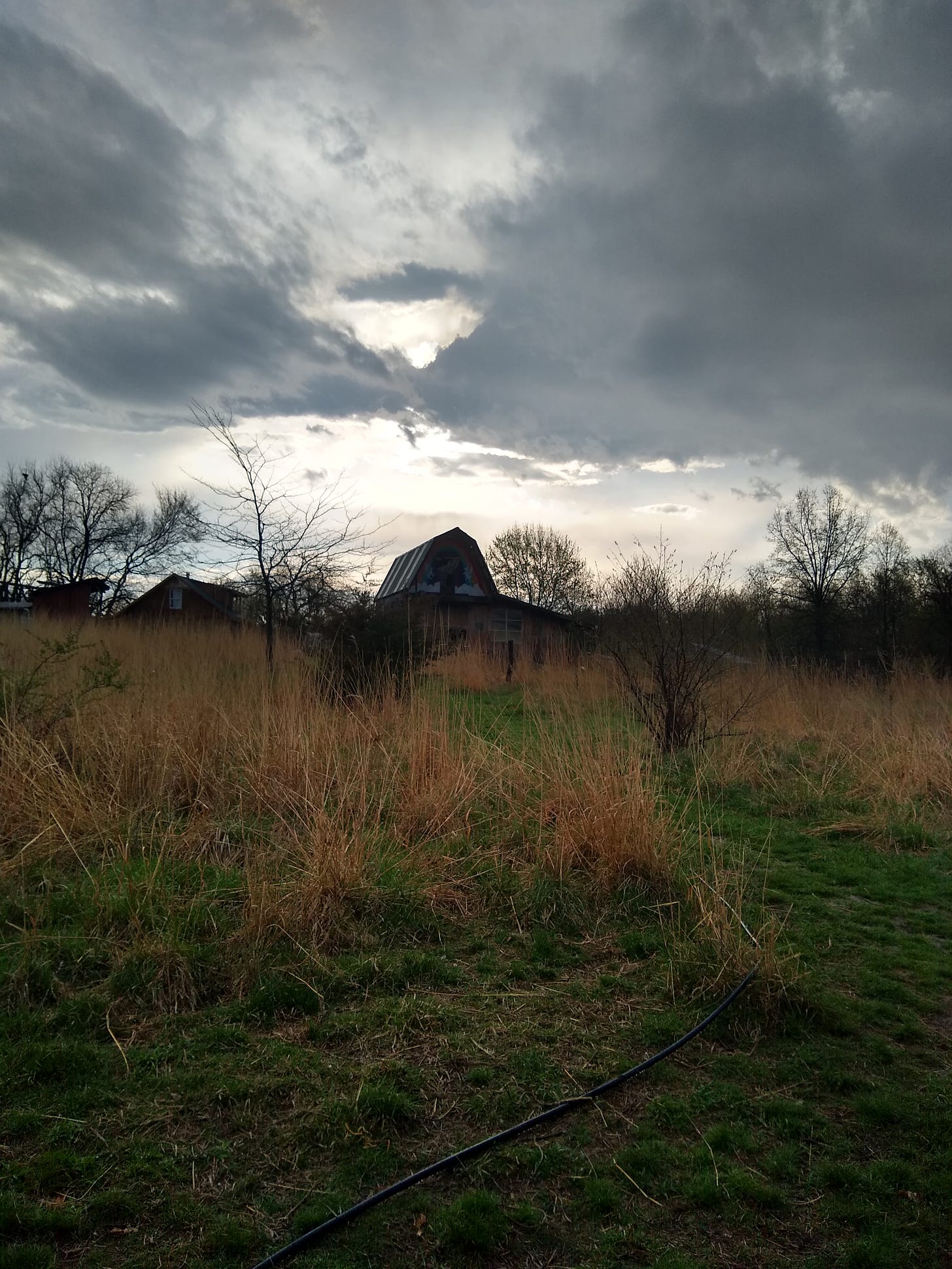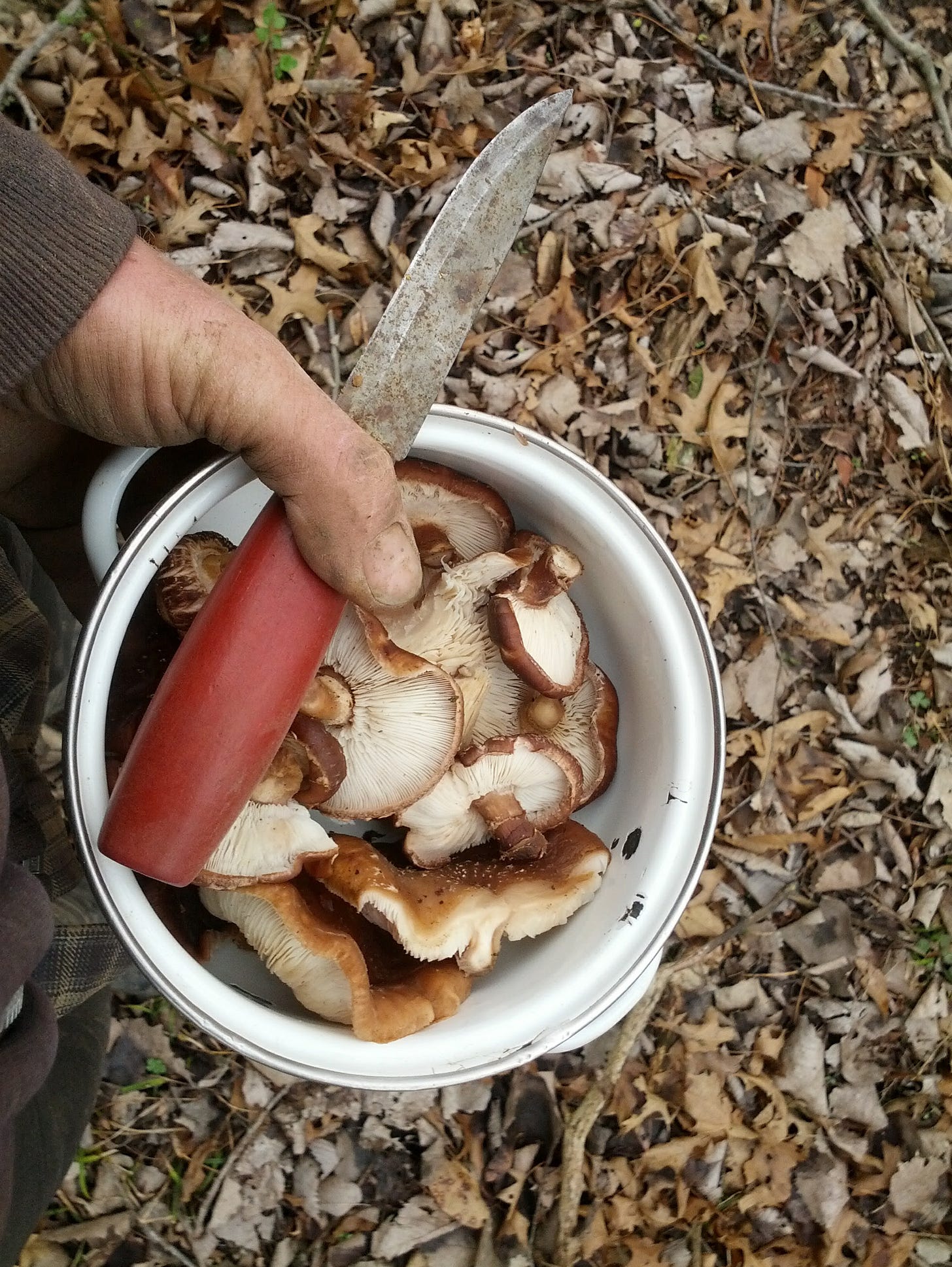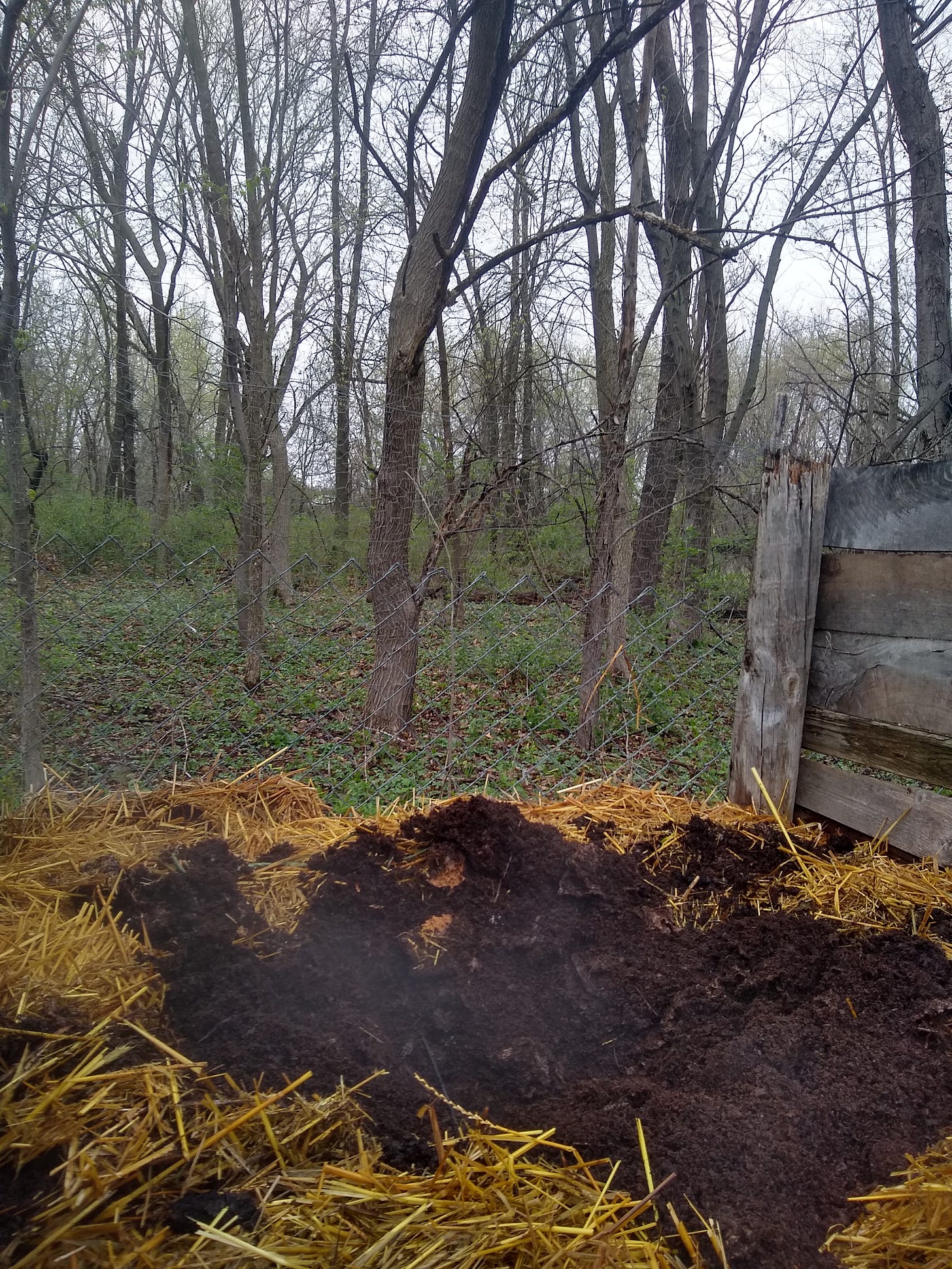Rats, Agriculture, and Civilization
Three things I can live with
The roosters are barely crowing yet this morning, and our pastures have finally been kissed by a little overnight rain in this unsettlingly dry April. Pear, peach, and serviceberry have all blossomed, and fungi in many forms are flaunting their fruiting bodies out in the open. If the warm temps hold for a bit longer, we might just find some morels out in patches we know of, if we have the time. The asparagus has been shy so far, again probably from a lack of moisture, but I expect it to start popping soon. Asparagus season and morel season line up for us… of course there’s other indicators of when morels may be appearing, my favorite being that they begin to appear at about the time that “the oak leaves are the size of a squirrel’s ear”. I don’t know that I can really tell what size a squirrel’s ear is by recollection alone, so I go with observing when the maypops are in bloom. Either way, I’m not much of a forager anymore. I try to chase down enough mushrooms every spring to fix up a tasty meal, but that’s about it. I stay back home on spring days, where I’m more useful.
Some folks are a bit more obsessive about morel hunting around here. Tromping around in the woods, staring at the ground, and gathering ticks may be a calming activity for some, but I personally prefer the more certain reward of agriculture over foraging and hunting. I’m a busy fella. I can’t afford to spend time wandering for food, or sitting still in the brambles with my butt wet, hoping a deer will walk by. Growing a garden, planting tree crops, raising livestock, and even inoculating our own mushroom logs affords us a level of control and security that wending through the woods in search of nutrition cannot guarantee.
Cultivating shiitakes provides us with mushrooms we don’t have to spend all day hunting for.
How we take the reins in our food system matters. I believe that all agriculture is, by necessity, a compromise between natural systems and human need. I try to err on the side of growing food in a way that integrates with our ecosystem rather than outright competes with it. I’ll be honest, I don’t know that I’m doing a good job or the right thing a lot of the time. But I’ve concluded that this is the compromise we must make on a planet with eight billion people. I’ve known and know of some pretty hardcore anarcho-primitivists who eschew all forms of agriculture in favor of a hunter-gatherer system. It’s arguably a noble ethic in terms of relationship between humans and land, but it’s also effectively a death sentence for most of our global human population, so I can’t really get behind it. Ideologies are like that sometimes, and to be fair, most everything our civilization is engaged in pretty much spells out peril and doom for humans, so they got me there.
Also, have you ever met an anarcho-primitivist who wants to go pre-agriculture? They are by and large insufferable. In the arc of human history, a hunter gatherer lifestyle has been a valid way for human communities to survive in integration with their ecosystem. It doesn’t appear viable anymore, outside of some indigenous communities, at a time when humans would best serve themselves by staying out of certain ecosystems and wild lands altogether. I was something of an anarcho-primitivist myself once, for probably a solid eight months. As an ideology, I enjoyed the feeling of smugness, but in practice, I was hungry and existentially lonely. While not all anarcho-primitives (#NotAllAnarchoPrimitives) or self-identified feral humans are misanthropic, selfish and priveleged, I’ve come to figure out that I was, and I think there’s probably a fair bit of cross over there. Also, you can’t tell people you’re feral if you’re using words, you’ve got to bite and growl to convince me.
One of the ways in which I was and still am privileged is that I have access to arable land. This privilege comes with a responsibility to steward it with integrity, obtain a yield and make the surplus available. While I’m in favor of ecosystem restoration, and actively seek to employ practices that can regenerate healthy, natural systems, I don’t condone throwing my hands up and leaving human existence to chance and survival of the fittest. But if I’m being honest with you, I did usta’ basically think this way. Trauma from watching mass-extinction unfold, I reckon.
I’m still something of an anarchist myself, and as such, I believe in mutualizing our survival. Hunting and gathering in the past was cooperative and organized. To fully embrace a hunter gatherer lifestyle over agriculture in the 21st century is often an act of misanthropy, and while I agree that humans are a bunch of bastards, I still feel obliged to provide for them. If you like gathering mushrooms, eating wild greens, or shooting squirrels, I’m good with all these things when performed responsibly. These are all fine hobbies, but I’d hardly count them as virtuous, unless these activities are organized to somehow provide sustenance to a larger community. And eat the problematic greens first, please! In our community, we get by on garlic mustard and nettle this time of year, foraging activities that are not particularly invasive or extractive. If I see a lot of morels, I take a few, leave a few. I like picking up a few ticks now and then, keeps me on my toes.
And so, imperfect as it is, we’re stuck with agriculture in some form, so long as we agree we’re not into mass starvation as a species. Agriculture inevitably begets civilization and surplus, and civilization and surplus are the key factors in promoting a healthy population of rats. And that’s what I really want to write about today.
Ah yes, the abundant, fecund brown rat. They come in waves here. I do my best to control them in the least ecologically harmful manner, and hold these attempts in context of the ecological harm that hordes of rats can inflict on our larger farmstead ecosystem. Honestly, the biggest thing these anarcho-primitivist hunter gatherers could probably do is eat more rats. A rat will eat anything it can get to, like ground nesting bird eggs, baby chicks, subsistence crops, or a wide spectrum of manure and feces. They burrow into gardens, into houses, they stink, and there’s always someone around to defend their intellect and justify their proliferation. Most assuredly, some of my readers are rat people, and that’s fine. But this is a different strain. Rats are inextricably linked with the excess of civilization, and that includes me.
As much as I try not to, I consume a small amount of digital homesteading media. There are things people tend to share, mostly their lush gardens, healthy livestock, happy children, well-stocked pantries full of colorful canned goods, and neatly stacked firewood. Nobody ever talks about rats, but come on, I know y’all have them. If a person claims to be living an agrarian lifestyle without the presence of rodentia, well, they’re lying about something, or maybe they don’t go walking around their farm with a headlamp at night as much as I do. Of course, anarcho-primitivists probably don’t have too many rats, on account of not having any food. Me, I’d rather have rats and food than no rats and no food, or just rats and no food.
Rats are unavoidable when your whole life revolves around food and manure. But I don’t think we should be resigned to our fate of being overtaken by hordes of vermin… there are a handful of ways to keep rat populations under control, but I don’t think we’re ever going to be totally free of them. In my experience, using poison bait and even trapping don’t address the cause of rats only treat the symptoms. These techniques temporarily reduce rat populations, yes, but if you, as a human being, continue to provide rat habitat, you will have rats. Even out away from civilization.
Keeping a cat around the house can greatly improve your living conditions, provided the cat is not like mine, who hasn’t any real hunting skills. She takes after me, I guess. While cats can deter and control rodent populations near human habitations, encouraging widespread hunting across your land with cats can have a negative effect on native wildlife populations, particularly ground nesting birds. Of course, many human activities, like mowing and agriculture have similar issues. We outfit our cat with a brightly colored collar to help alert potential prey to her presence, but honestly, she mostly just sleeps and stares out the window, molesting neither meadowlark nor rat.
Managing brush, brush piles and other debris is a way to reduce rat habitat. Brush and debris are unavoidable on most homesteads. If we make a pile that we can’t immediately burn in our biochar kiln, we find positioning the pile well away from other structures or debris creates an island effect, in which rats must cross open expanses and leave themselves vulnerable to owls and other predators. As a general rule of thumb, if I cannot use my scythe to mow between a debris pile and the nearest structure, it is too close. But I don’t like to follow rules all the time, particularly my own.
It should seem obvious that rats appreciate food access, so this is an clear place to increase security. I only provide as much grain to our poultry as they can consume in an hour, so that there is little excess to be gleaned, and we do our best to store all of our surplus goods in buckets, barrels, jars, and the like. This gets more difficult with gardening, and I have had a few incidents of vermin mining sweet potato beds, burrowing into squash, and climbing cornstalks. Without access to the kinds of food that you or I recognize as food, rats will actively eat into manure piles. Placement of compost piles well away from other areas of human activity can reduce rodent impact at home. And this is where I have a hard time with rats.
We are on a humanure composting system here, which is a fancy way of saying we dump our shit in a (properly managed and safely composted) pile in favor of polluting water based systems. That’s a whole other subject for a different newsletter. Point is, rats will get into our humanure bins sometimes. Rats eat human feces, as do dogs sometimes, but I’m way more of a dog person, and so I draw the line with vermin as best I can. Just like old Hollywood movies just never depicted the existence of a bathroom or humans sharing a bed, homesteading social media never depicts hordes of rats descending on a poop pile, and I’m calling it out.
A steaming hot humanure compost bin. We need to make this more popular.
This year, our rat population feels reasonable, manageable, under control. There’s a lot of factors. I’m not saying we should be too proud of having a lot of rats, but some rats are a part of farm life. Our house is bermed with full ground contact, insulated with straw, and plastered with earth. You’d better believe we get a rat or two. When I hear them, it’s night time, and scratching and gnawing is pretty threatening when it’s located in the roof above our heads. We can usually trap or otherwise control small invasions like this as needed. Back about a decade, I began my homesteading journey in a little homemade yurt with my family and dog. That winter, we were plagued with rats that would literally steal food off the stove and scritch in our drawers all night. I didn’t know then that these were shit-eating rats. Look out for the shit-eating rats, y’all. I mean it, the simple life really blows sometimes, and sometimes good, clean living is neither.
Anyhow, the morning rain is passing here, perhaps long enough for me to run out and begin the never ending and burdensome activity of farming. There will be mud to slip in, wet chickens (never a good smell), and if I’m lucky, a drowned rat or two. My primary focus, outside of survival and doing the best for my farmstead, family, and friends is helping to develop a collective agroforestry project, and yesterday was the first day of work on a community mushroom cultivation project. It might suck the fun out of looking for mushrooms, but we know we’ll get a few, hopefully a lot. A lot of ticks and rats, if not a lot of food.
In manageable pestilience,
BB
Some quick housekeeping for the Almanac. As I further commit to writing, and hope folks find it informative, thought provoking, or modestly entertaining, I’ve begun working simultaneously on several longer pieces about collectivized agriculture, how resilience and efficiency relate to the food supply chain, scything, and a homestead fashion review. I’m also looking to collaborate with you, the reader, for some Q&A’s and advice column style pieces, or anything you pitch, really.
Some of these projects are scheduled to be published to paid subscribers, and as I gradually learn more about substack and how it works (I’m not a technology person, if you didn’t know) I have recently uncovered how to change my subscription fees. I’m now offering the monthly support level at $5, or $50/year. Let’s say I’d take the money, if you’re not using it. But if you can’t afford a subscription and you REALLY want access to something from my archives or the paid feed, holler at me, and we can work something out. I hope you enjoy reading my little pitch more than I enjoyed writing it.





As to the housekeeping at the bottom - when I subscribed I'd wished there was a 'choose your own adventure' option with how much to pay per month/year. Is that a thing substack/you'd allow?
Does integrating the biochar into the humanure do anything noticeable to affect the rats' interest in said piles?